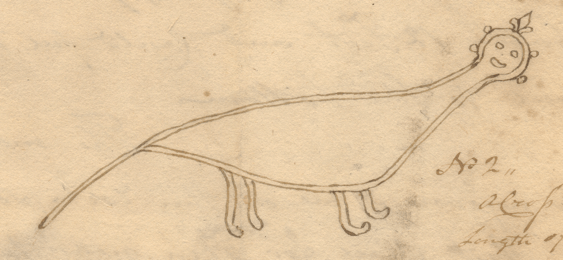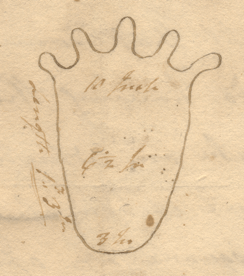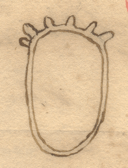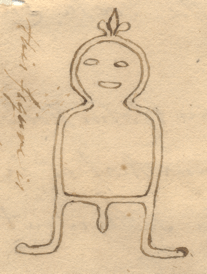Benjamin Henfrey’s Drawings of Petroglyphs, 31 December 1798 [document added in digital edition]
Benjamin Henfrey’s Drawings of Petroglyphs
ca. 1798?
The rock on which these Figures are Cut is 50 miles below Fort Pit on the Nor. side the Ohio
No 1

| No [1] | F. In |
| Head | 10 |
| Between Eyes | 3 |
| Length of Body | 1 – 6 |
| Eyes to Mouth | 0 – 4 |
| Body in the | |
| thickest part | 1 – 0 |
| Neck | 4 |
| Legs | 1 – 0 |
| Foot | 0 – 8 |

| No 2 | F. In |
| A Cross the head | 0 – 5 |
| Length of Body | 1 – 8 |
| A Cross the Body | 0 – 6 |
| Tail | 0 – 8 |
| Legs | 0 – 5 |

Length 1 F 3 In


(this figure is 1 Foot long)
These Curious Hieroglyphs, are Picked in lines on a very hard Black Granite rock the surface even and orizontal, the markes of a Tool was very visible in the lines
There was upwards of a hundred more but I had not time to take them Consisting of different Beasts & Fishes
I also observed many that was evidently meant to represent the feet of Animals, and was Very natural—
I thought that some was meant to describe Certain roads having that resemblance—
The rock on which these Hieroglyphics are picked out exibits a plain surface equal to a square of about 20 Feet—the river here was deep, I put down a pole about 12 Feet and could feel the rock continue to the bottom
The man (John Hooton) who informed me of this rock says that it is the best place for Fish near his settlement and my Opinion lies that the Indians may have amused themselves in makeing those figures when fishing there and that they were Cut or Picked out at many different times, I have inquired respecting this Idea of many Savages but I never met with one who could give me any Information on the subject—
B. Henfrey
MS (DLC: TJ Papers, 128:22150); entirely in Henfrey’s hand; undated (see below); drawings arranged in two rows; numeral in brackets, lacking in MS, supplied by Editors; endorsed by TJ: “Indians. from Genl. Wilkinson.”
rock on which these Figures are Cut: the petroglyphs drawn by Henfrey were along the Ohio River in what became Columbiana County, Ohio. Archaeologists identify the location as the Dam No. 8 site. It has also been called the Wellsville site. Most of what is known of the pictures of animals, people, mythological creatures, and geometric designs incised in the sandstone there comes from information collected in 1908 and 1909, before the construction of a dam destroyed some of the images and put the others beneath water and mud. Some published illustrations of the pictures, taken from rubbings made before the site was flooded, are mirror images of the petroglyphs as Henfrey saw them and drew them (James L. Swauger, Rock Art of the Upper Ohio Valley, artwork by Clifford J. Morrow [Graz, Austria, 1974], 34-7, pl. 14-17; Leroy G. Banks, “Rock Carvings in the Ohio River,” Archaeological Bulletin, 1 [1910], 38-41; James L. Swauger, “The East Liverpool Petroglyph Data: A Tribute,” Pennsylvania Archaeologist, 33 [1963], 127-9).
John Hooten (Hooton) died in March 1798 when his canoe capsized in the Ohio River about 50 miles below Pittsburgh. Although few details of Henfrey’s travels are known, he was at Fort Wayne in June 1798. He had obtained the release of a captive held by the Potawatomi Indians, which probably means that he had been in the westernmost parts of the Northwest Territory. He perhaps saw the petroglyphs on the Ohio River sometime earlier, on his way west (Washington, Pa., Herald of Liberty, 19 Mch. 1798; Baltimore Patriot, 8 Aug. 1828; Vol. 36:169n).

![University of Virginia Press [link will open in a new window] University of Virginia Press](/lib/media/rotunda-white-on-blue.png)
